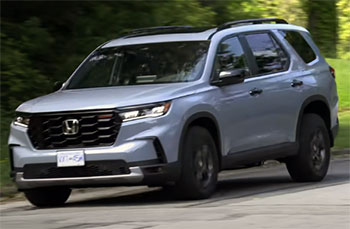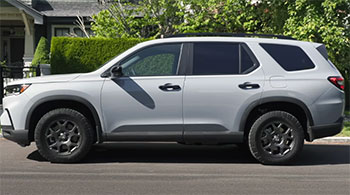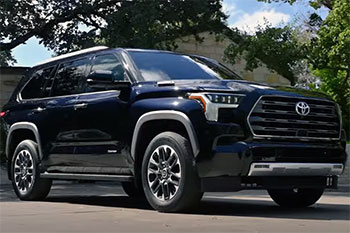As a parent of three and an avid road-tripper, I’ve spent countless hours researching the perfect SUV to haul my family, gear, and dreams across highways and backroads. The Honda Pilot and Toyota Sequoia emerged as top contenders, each promising space, power, and reliability.
I share my firsthand experience comparing these three-row SUVs, weighing their pros and cons through real-world scenarios. With a detailed comparison table, personal insights, and a conversational tone, I’ll help you decide which vehicle suits your lifestyle best, whether you’re after efficiency, off-road prowess, or family-friendly features.
Comparison Table: Honda Pilot vs. Toyota Sequoia
| Feature | Honda Pilot (2025) | Toyota Sequoia (2025) |
|---|---|---|
| Starting MSRP | $41,650 | $64,370 |
| Engine | 3.5L V6 (285 hp, 262 lb-ft) | 3.4L Twin-Turbo V6 Hybrid (437 hp, 583 lb-ft) |
| Transmission | 10-speed automatic | 10-speed automatic |
| Fuel Economy (MPG) | 19 city / 27 highway / 23 combined | 21 city / 24 highway / 22 combined |
| Seating Capacity | Up to 8 | Up to 8 |
| Cargo Space (cu ft) | 18.6 behind 3rd row, 87.0 max | 22.3 behind 3rd row, 87.0 max |
| Towing Capacity | 5,000 lbs (AWD) | 9,520 lbs (AWD) |
| Drive Options | FWD or AWD | RWD or AWD |
| Infotainment | 9.0-inch touchscreen, Apple CarPlay, Android Auto | 12.3-inch touchscreen, Apple CarPlay, Android Auto |
| Safety Rating | IIHS Top Safety Pick (2024) | Not yet rated (2024) |
| Reliability (J.D. Power) | Below average (2024) | Above average (2024) |
My Experience With the Honda Pilot

Driving the 2025 Honda Pilot felt like slipping into a familiar pair of sneakers—comfortable, reliable, and ready for the daily grind.
I tested the Elite trim, which comes loaded with features like heated and ventilated seats, a panoramic sunroof, and a slick 9.0-inch touchscreen.
The Pilot’s midsize footprint made it a breeze to navigate through city traffic and tight parking lots, a godsend during my weekly grocery runs with the kids.
Its 3.5-liter V6 engine, producing 285 horsepower, handled highway merges decently, though I noticed it strained a bit when passing at higher speeds.
The 10-speed automatic transmission shifted smoothly, and the optional all-wheel drive gave me confidence on wet roads during a rainy weekend trip.
Inside, the Pilot’s cabin felt like a cozy family hub. The second-row seats offered generous legroom, and the Magic Slide feature made it easy for my kids to hop into the third row without a wrestling match. With 18.6 cubic feet of cargo space behind the third row, I could fit strollers and sports gear, and folding the seats down opened up a cavernous 87.0 cubic feet.
The infotainment system was intuitive, syncing effortlessly with my phone, though the 9.0-inch screen felt a tad small compared to competitors. Safety features, like the adaptive cruise control and lane-keeping assist, worked seamlessly, earning the Pilot its IIHS Top Safety Pick status. However, the tiny shifter buttons were a minor annoyance, especially when parking in a hurry.
On a family camping trip, the Pilot’s fuel efficiency (23 MPG combined) saved me a few bucks at the pump, and the cap-less fueling system was a small but appreciated convenience. Towing our 3,500-pound trailer was manageable, though the 5,000-pound limit meant I had to pack light. Off-road, the Pilot’s TrailSport trim showed some grit on gravel paths, but it’s no rock-crawler. Overall, the Pilot felt like a practical, budget-friendly choice for families who prioritize comfort and efficiency over raw power or luxury.
Read More: My Thoughts On Acura MDX Vs. Volvo XC90
Pros Of the Honda Pilot
- Affordable Price Point: Starting at $41,650, the Pilot is significantly cheaper than the Sequoia, saving you over $20,000. This makes it a fantastic value for families on a budget, offering premium features like leather seats and advanced safety tech without breaking the bank.
- Fuel Efficiency: With 19 MPG city and 27 MPG highway, the Pilot sips fuel compared to the Sequoia’s thirstier hybrid. On long road trips, this translated to fewer stops and lower costs, especially with regular unleaded gas instead of premium.
- Maneuverability: The Pilot’s midsize design makes it nimble in urban settings. I easily parked in crowded lots and weaved through traffic, which felt less stressful than handling a larger SUV.
- Family-Friendly Interior: The Magic Slide second-row seats were a game-changer, making third-row access a breeze. My kids loved the spacious second row, and the 87.0 cubic feet of max cargo space swallowed all our gear for a weekend getaway.
- Advanced Safety Features: The Pilot’s IIHS Top Safety Pick rating gave me peace of mind. Features like low-speed braking control and a multi-view camera system helped me avoid fender-benders in busy parking lots.
- Cap-Less Fueling: This small feature saved time and hassle at gas stations. No more fumbling with a fuel cap—just insert the nozzle and go.
- Smooth Ride Quality: The Pilot’s suspension soaked up bumps on rough roads, making long drives comfortable. My family appreciated the quiet cabin, even at highway speeds.
Cons Of the Honda Pilot

- Sluggish Acceleration: The 285-horsepower V6 felt underpowered when passing on highways or towing. It took 7.2 seconds to hit 60 MPH, which was noticeable when merging into fast-moving traffic.
- Limited Towing Capacity: Capped at 5,000 pounds, the Pilot struggled with our heavier trailer. If you tow frequently or need to haul heavy loads, this could be a dealbreaker.
- Smaller Touchscreen: The 9.0-inch touchscreen, while functional, felt dated compared to larger screens in competitors. Reaching it from the driver’s seat was also a stretch.
- Fussy Shifter Buttons: The tiny push-button shifter was frustrating to use, especially in a rush. I fumbled more than once trying to hit the Park button.
- Below-Average Reliability: J.D. Power’s 2024 survey ranked Honda below average, with 59 more problems per 100 vehicles than Toyota. This gave me pause about long-term dependability.
- Limited Off-Road Capability: Even the TrailSport trim isn’t built for serious off-roading. It handled light trails fine, but don’t expect to tackle rugged terrain.
- Less Cargo Space Behind Third Row: With 18.6 cubic feet, the Pilot has less room for gear with all seats up compared to the Sequoia’s 22.3 cubic feet, which cramped our packing for day trips.
My Experience With the Toyota Sequoia

The 2025 Toyota Sequoia was a beast of a different breed, exuding power and presence.
I drove the Capstone trim, a hybrid monster with a 3.4-liter twin-turbo V6 pumping out 437 horsepower and 583 pound-feet of torque.
From the moment I hit the gas, the Sequoia surged forward, making highway passes and towing a 7,000-pound trailer feel effortless.
Its 10-speed automatic transmission was buttery smooth, and the full-time four-wheel drive gripped the road like a champ during a snowy mountain drive.
However, its size made city driving a bit daunting, especially in tight spaces.
The Sequoia’s interior screamed upscale, with rose-gold accents and a massive 12.3-inch touchscreen that dominated the dashboard.
The cabin felt luxurious, though the center console was a bit cluttered. Second-row captain’s chairs (optional) made it easy to access the third row, but the standard bench seat was less flexible than the Pilot’s. Cargo space was generous—22.3 cubic feet behind the third row—and the 9,520-pound towing capacity blew the Pilot out of the water.
Off-road, the Sequoia’s TRD Pro trim shone, with features like Downhill Assist Control making steep descents a breeze.
Fuel economy was a mixed bag; the hybrid system delivered 22 MPG combined, but the premium fuel requirement stung my wallet. Reliability, however, was a strong suit—Toyota ranked second in J.D. Power’s 2024 survey, and the Sequoia’s battery placement in the trunk promised longevity. Safety features matched the Pilot’s, but the lack of an IIHS rating for 2024 left me curious. The Sequoia felt like a powerhouse built for adventure, but its price and size might overwhelm budget-conscious or urban drivers.
Pros Of the Toyota Sequoia
- Powerful Hybrid Engine: The 437-horsepower twin-turbo V6 hybrid is a beast, delivering 583 pound-feet of torque. It made towing and highway driving a thrill, with a 0-60 MPH time that felt much quicker than the Pilot.
- Impressive Towing Capacity: With a 9,520-pound limit, the Sequoia handled heavy trailers with ease. I towed a boat without breaking a sweat, unlike the Pilot’s struggle.
- Spacious Cargo Area: Offering 22.3 cubic feet behind the third row, the Sequoia fit more gear than the Pilot, perfect for family trips or hauling sports equipment.
- Luxurious Interior: The Capstone trim’s faux suede, leather, and rose-gold accents felt premium. The 12.3-inch touchscreen was responsive and easy to use, outshining the Pilot’s smaller display.
- Superior Reliability: Toyota’s second-place ranking in J.D. Power’s 2024 reliability survey gave me confidence in the Sequoia’s long-term dependability, unlike the Pilot’s below-average score.
- Off-Road Prowess: The TRD Pro trim’s Downhill Assist Control and skid plates made light off-roading a breeze. It tackled rugged trails far better than the Pilot’s TrailSport.
- Larger Fuel Tank: With a 22.5-gallon tank, the Sequoia offered a longer range between fill-ups, ideal for cross-country adventures.
Cons Of the Toyota Sequoia
- High Price Tag: Starting at $64,370, the Sequoia is over $20,000 more expensive than the Pilot. This premium price might be a stretch for budget-conscious families.
- Poor Fuel Economy for a Hybrid: Despite being a hybrid, the Sequoia’s 22 MPG combined was only slightly worse than the Pilot’s, but it requires pricier premium fuel.
- Cumbersome Size: The Sequoia’s full-size frame made parking and city driving challenging. I scraped a curb trying to maneuver into a tight spot.
- Cluttered Center Console: The console’s design felt busy, with the wireless charging pad awkwardly tucked under the dash, making phone retrieval a hassle.
- No IIHS Safety Rating: Unlike the Pilot’s Top Safety Pick status, the Sequoia lacks a 2024 IIHS rating, leaving its crash-test performance unverified.
- Less Flexible Seating: The second-row bench seat didn’t slide like the Pilot’s Magic Slide, making third-row access trickier without captain’s chairs.
- Premium Fuel Requirement: The need for premium gas added about 82 cents per gallon to my fuel costs, a noticeable hit on long trips.
Read More: My Thoughts On Acura MDX Vs. Jeep Grand Cherokee
Frequently Asked Questions (FAQ)
It depends on your needs. The Pilot is better for budget-conscious families who value fuel efficiency and maneuverability. The Sequoia excels for those needing towing power, off-road capability, and a luxurious interior, but it’s pricier.
The Toyota Grand Highlander is closer in size and price to the Honda Pilot, offering similar midsize SUV features. The Sequoia is a full-size SUV, a step above.
The Pilot has sluggish acceleration, limited towing capacity (5,000 lbs), a smaller touchscreen, fussy shifter buttons, below-average reliability, and limited off-road capability.
The Ford Expedition, Chevrolet Tahoe, and Nissan Armada are full-size SUVs comparable to the Sequoia, offering similar towing, cargo space, and off-road features.
Conclusion: For Honda Pilot and Toyota Sequoia
You’re probably wondering which SUV I’d pick after spending time with both. Honestly, it’s a tough call, and it hinges on what you value most. If you’re like me—a busy parent juggling school runs, groceries, and occasional adventures—the Honda Pilot is a practical, wallet-friendly choice. Its fuel efficiency, nimble handling, and family-focused features like Magic Slide seats make it a daily driver you can rely on without draining your savings. But if you crave power, luxury, and the ability to tow heavy loads or venture off-road, the Toyota Sequoia is your beast. Its hybrid engine, plush interior, and unmatched towing capacity make it a dream for big families or outdoor enthusiasts, though the price and fuel costs might give you pause.
Both SUVs have their strengths, and neither is perfect. The Pilot’s sluggish performance and reliability concerns could frustrate you over time, while the Sequoia’s size and cost might feel excessive for city life. I leaned toward the Pilot for its affordability and ease in urban settings, but the Sequoia’s raw power stole my heart on open roads. Test-drive both, think about your budget, and picture your family’s needs—whether it’s hauling kids or conquering trails, one of these SUVs will fit your life like a glove.

